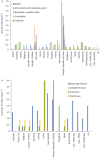Understanding the pathogenesis of occupational coal and silica dust-associated lung disease
- PMID: 35831008
- PMCID: PMC9724915
- DOI: 10.1183/16000617.0250-2021
Understanding the pathogenesis of occupational coal and silica dust-associated lung disease
Abstract
Workers in the mining and construction industries are at increased risk of respiratory and other diseases as a result of being exposed to harmful levels of airborne particulate matter (PM) for extended periods of time. While clear links have been established between PM exposure and the development of occupational lung disease, the mechanisms are still poorly understood. A greater understanding of how exposures to different levels and types of PM encountered in mining and construction workplaces affect pathophysiological processes in the airways and lungs and result in different forms of occupational lung disease is urgently required. Such information is needed to inform safe exposure limits and monitoring guidelines for different types of PM and development of biomarkers for earlier disease diagnosis. Suspended particles with a 50% cut-off aerodynamic diameter of 10 µm and 2.5 µm are considered biologically active owing to their ability to bypass the upper respiratory tract's defences and penetrate deep into the lung parenchyma, where they induce potentially irreversible damage, impair lung function and reduce the quality of life. Here we review the current understanding of occupational respiratory diseases, including coal worker pneumoconiosis and silicosis, and how PM exposure may affect pathophysiological responses in the airways and lungs. We also highlight the use of experimental models for better understanding these mechanisms of pathogenesis. We outline the urgency for revised dust control strategies, and the need for evidence-based identification of safe level exposures using clinical and experimental studies to better protect workers' health.
Copyright ©The authors 2022.
Conflict of interest statement
Conflict of interest: No conflict of interest.
Figures




References
-
- World Health Organization . Ambient (Outdoor) Air Quality and Health. www.who.int/news-room/fact-sheets/detail/ambient-(outdoor)-air-quality-a... Date last accessed: May 2, 2018. Date last updated: September 22, 2021.
-
- World Health Organization . Ambient Air Pollution: Health Impacts. www.who.int/airpollution/ambient/health-impacts/en/ Date last accessed: Mar 24, 2020.
Publication types
MeSH terms
Substances
LinkOut - more resources
Full Text Sources
Medical
